Wandering Jew plants, also known as Tradescantia in the scientific community, are a charming collection of indoor plants that have captured the attention of plant lovers with their eye-catching hues and lovely leaves. Due to their simplicity of maintenance and attractive look, these lovely plants, which are native to South and Central America, are now well-liked options for indoor gardening. We shall examine eight remarkable Wandering Jew plant kinds in this post, each of which has distinguishing qualities. In addition, we’ll provide crucial maintenance advice to make sure these plants flourish in your house.
1. Tradescantia Fluminensis
A attractive and adaptable member of the Tradescantia genus, Tradescantia Fluminensis is also known as small-leaf spiderwort, river spiderwort, inch plant, swift Henry, and wandering willie. It is recognized for having elegant-looking, oval, dark-green leaves with shiny, pointy tips. Due to its alluring appearance and simplicity of growth, Tradescantia Fluminensis, which is native to South America, has become more well-known worldwide.
A variety of indoor and outdoor areas benefit greatly from the addition of this beautiful species’ vibrant greenery. It is a great option for establishing a rich ground cover in small spaces like hanging baskets, planters, or window boxes due to its trailing and creeping growth patterns. The plant is a popular choice for both gardeners and fans of indoor plants due to its flexibility to various habitats and lighting conditions.
One of Tradescantia Fluminensis’ noteworthy qualities is its straightforward and rapid rooting, which makes propagation simple for both novice and seasoned gardeners. Snipping a healthy stem and putting it in water or wet soil can cause new roots to grow, creating a new plant. Its extensive presence in many homes and gardens is largely due to its ease of spreading.
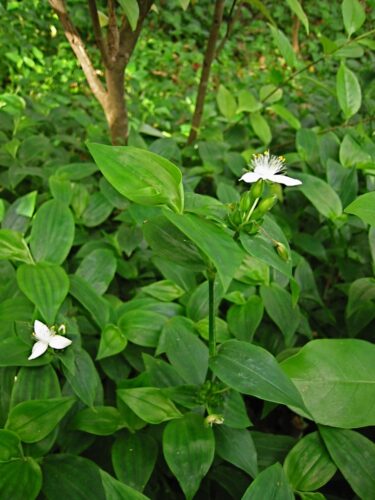
Tradescantia Fluminensis has being researched for its possible health benefits and role in enhancing indoor air quality, in addition to its aesthetic appeal and ease of cultivation. This species, like many indoor plants, aids in air purification by eliminating dangerous chemicals and pollutants, fostering a better living environment. In addition, keeping plants inside has been associated with lowering stress levels and improving general well-being, making Tradescantia Fluminensis a beneficial addition to any indoor setting.
Although Tradescantia Fluminensis is often low maintenance, adequate care is necessary for it to have the best health and lifespan. It is great for well-lit interior spaces or shaded outdoor settings since it thrives in bright, indirect light. Avoid direct sunlight as much as possible since it might burn the tender foliage. While routine watering is required, excessive watering should be avoided to avoid root rot. It is advised to choose a soil mixture that drains properly to guarantee appropriate drainage.
Regular trimming is advantageous to maintain the plant’s lush look and avoid legginess. Trimming the stems promotes bushier growth and aids in preserving the compact shape of the plant. Additionally, the pruning cuttings may be utilized for propagation, guaranteeing a steady supply of new, fresh plants.
Despite being usually resilient, Tradescantia Fluminensis is prone to several pests and illnesses. The plant may get infested by common pests such mealybugs, aphids, and spider mites. To keep these pests under control, do routine inspections and use natural pesticides as soon as possible. If the plant is continually overwatered or if the soil is left too moist, root rot and fungal infections may develop. The key to avoiding these problems is using the right watering techniques and making sure there is enough drainage.
Care Tips: Tradescantia Fluminensis thrives in bright, indirect light and prefers well-draining soil. Regular watering is necessary, allowing the soil to dry out slightly between waterings. Maintain a humid environment, and trim leggy growth to promote bushiness.
2. Tradescantia Zebrina
Wandering Jew plants are known for their distinctive and vibrant leaves, and they make a striking accent to any setting. The Zebrina variety stands out among the other types because to its captivating deep green leaves adorned with eye-catching silver or white stripes, producing a zebra-like pattern that lends a touch of class to any interior décor.
The leaves of the Zebrina Wandering Jew are a popular option for interior decorating due to their distinctive look. The deep green backdrop acts as a blank canvas for the silver or white stripes, resulting in a magnificent show that improves the aesthetic of any space. Each leaf transforms into a living, vibrant piece of art, enhancing the surroundings.
The Wandering Jew’s tendency of cascading growth, especially the Zebrina species, is one of its most alluring features. When a plant reaches maturity, its trailing tendrils gracefully descend and gracefully pour over shelves or hanging baskets, producing an amazing display. This cascading quality gives vertical spaces a dynamic appeal that transforms plain walls into alive, breathing artworks. Any area gains a feeling of movement and beauty from the Wandering Jew’s foliage’s beautiful draping.
Beyond their visual appeal, Wandering Jew plants are highly adaptable and can thrive in a variety of environments, which makes them well-liked among plant lovers and interior designers. The Wandering Jew instantly enhances any setting, adding life to previously inconspicuous locations, whether it is a sunny windowsill, a warm bookshelf, or a forgotten nook of a living room.
In addition to being attractive, Wandering Jew plants provide calmness and relaxation indoors. In any space, the relaxing tones and patterns of the leaves of the Zebrina Wandering Jew provide a pleasant mood. There is evidence that having greenery around may lower stress and anxiety by bringing people closer to nature, especially in metropolitan areas.
The Wandering Jew is a popular ornamental houseplant since it requires little maintenance. Although it may withstand lower light levels, it prefers direct, strong light. To keep the soil constantly wet without overwatering, regular irrigation is essential. The plant like moderate humidity, so spraying the leaves on occasion might be helpful, particularly in dry indoor settings.
The simple reproduction of the Wandering Jew is a nice feature. By taking stem cuttings and putting them in water or soil until they form roots, the plant conveniently permits the production of new ones as it develops. Giving these cuttings to friends and family allows recipients to experience the satisfaction of caring for and nurturing these endearing plants, adding a personal touch to any gift.
Plants known as “Wandering Jew” have been researched for possible health advantages in addition to their decorative appeal. They help to improve indoor air quality by removing dangerous poisons and pollutants, as many indoor plants do. The presence of these eco-friendly friends may improve the quality of life and promote both physical and mental wellness.
The historical and cultural connotations of the moniker “Wandering Jew” contribute to the attraction of these plants. The name is said to have been taken from a figure who mocked Jesus on the way to the cross and was doomed to wander the world forever, according to tradition and other stories. The plant now exudes a fascinating and magical atmosphere that appeals to people’s imaginations when they learn about this relationship.
Care Tips: Tradescantia Zebrina thrives in bright, indirect light, but it can tolerate lower light conditions. Keep the soil consistently moist, but avoid overwatering to prevent root rot. Pruning the plant regularly will help maintain its bushy and compact appearance.
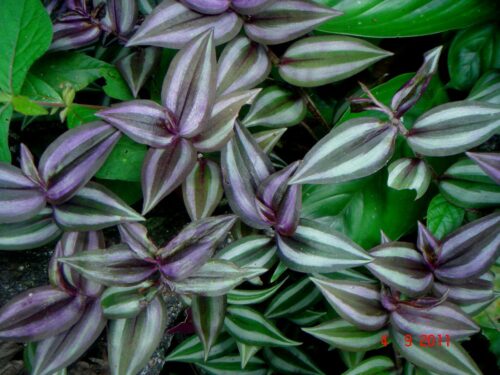
3. Tradescantia Pallida (Purple Heart)
The Tradescantia pallida ‘Purple Heart’ plant, often known as the Purple Heart plant, is a visually striking and seductive species that is endemic to northern Mexico, from Tamaulipas to Yucatan. Its lovely deep purple foliage and trailing growth pattern have given it the widespread name “Purple Heart.” This plant, which belongs to the family Commelinaceae, is widely prized for its aesthetic value and adaptability. Due to its persistence and flexibility, the Purple Heart is thought of as a fragile perennial even though it is often planted as an annual or houseplant in colder locations. It may reemerge in protected places or during mild winters, surprise gardeners with its perseverance.
The Purple Heart is a great option for landscaping and filling up empty spaces in gardens due to its high growth rate and trailing stems. Its capacity to offer lush ground cover injects a splash of color and vitality into any location, converting drab spaces into vivid and welcoming landscapes. Its popularity stems from both its spectacular look and minimal care requirements, making it a popular choice for gardeners of all experience levels. Once established, it requires little maintenance because to its hardiness and adaptability, which allow it to grow in a variety of soil types and light exposures.
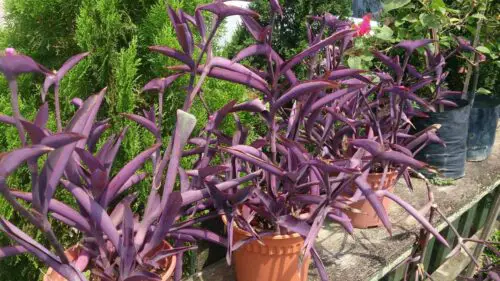
While the Purple Heart is generally valued for its ornamental qualities, it also has cultural importance and has traditionally been utilized in certain areas’ traditional medicine. Folk medicine has made use of Purple Heart extracts for their alleged analgesic and anti-inflammatory effects. However, as further scientific study is required to fully comprehend the plant’s possible therapeutic advantages, it is crucial to approach such usage with care and obtain appropriate medical advice.
For the Purple Heart plant to flourish and thrive to its full potential, proper care and attention are essential. Despite its adaptability, it prefers well-draining soil and direct sunshine to grow. To reduce the possibility of root rot, it is important to use careful watering techniques and avoid overwatering. Maintaining its compact form and promoting bushier growth by pruning and pinching back the stems may improve its overall appeal.
The Purple Heart is very easy to propagate, which allows gardeners to easily add to their collection or spread the word about this fascinating plant to others. Rooting stem cuttings in soil or water is simple, making it possible to easily grow new plants.
Let’s sum up by saying that the Purple Heart (Tradescantia pallida ‘Purple Heart’) is an alluring and useful plant distinguished by its bright purple leaves and trailing growth pattern. It comes from northern Mexico and has become well-known all over the globe for its ornamental qualities and flexibility. Its capacity to reappear in protected places or mild winters shows its resilience despite being regarded as an annual or houseplant in colder climates. It is a great option for landscaping and filling up bare spots in gardens because to its speedy growth and minimal care requirements. It is more than simply a pretty plant because of its cultural value and probable therapeutic benefits, which provide depth to its attractiveness. The Purple Heart will continue to delight gardeners and provide a touch of rustic beauty to any area when given the right attention and respect.
Care Tips: Tradescantia Pallida thrives in bright light but can tolerate partial shade. Allow the soil to dry slightly between waterings, but do not let it completely dry out. Regularly pinch off the tips to encourage branching and promote fuller growth.
4. Tradescantia Albiflora (Spiderwort)
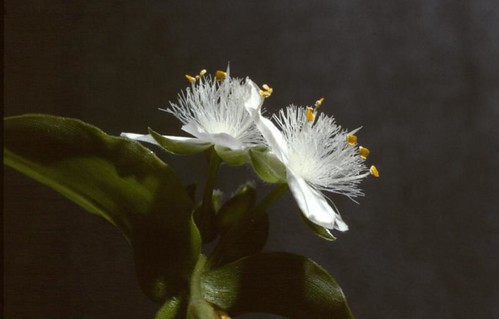
The coveted and alluring spiderwort, or Tradescantia albiflora as it is formally named, is recognized for its vivid white flowers that arise erratically throughout the year. Its foliage, which is a stunning shade of green with a tint of purple, only serves to increase its appeal. Because of its gorgeous blossoms and visually appealing leaves, this unusual and lovely plant has become a favorite among plant collectors and aficionados, adding beauty to any interior environment.
The pristine white petals of the Spiderwort’s blossoms are a sight to see as they contrast with the plant’s luxuriant green foliage. This stark contrast produces a visually beautiful spectacle that grabs viewers’ attention. The uneven flowering pattern that distinguishes this plant adds a sense of surprise and excitement as the lovely white blooms emerge erratically throughout the year. The Spiderwort has a dynamic and ever-evolving presence due to its inherent unpredictability, which infuses any area with its erratic beauty.
The Spiderwort’s foliage, in addition to its alluring blossoms, significantly contributes to its allure. The plant’s lovely green leaves with a faint purple undertone form an aesthetically appealing balance that gives the look of the plant depth and personality. The Spiderwort is a sought-after centerpiece in plant collections and indoor arrangements because to its striking blend of hues. With its distinctive leaves and sporadic bursts of white blossoms, it makes a striking addition to any interior environment.
For busy people or inexperienced gardeners, the Spiderwort’s ease of maintenance as an indoor plant is one of its most alluring features. It is a great alternative for folks who have limited outside area or inclement weather since it thrives inside. It will grow and blossom well in a sunny area with indirect sunshine and with regular watering that allows the soil to somewhat dry out between applications. The Spiderwort just needs a little maintenance to thrive and enchant with its gorgeous flowers and lovely leaves.
The Spiderwort has a long history and significant cultural value in addition to its beauty and minimal care requirements. Indigenous people around the world have historically employed spiderwort plants for therapeutic and medical reasons. The plant’s extracts were used in ancient medicines to treat illnesses and improve overall health since it was thought that they had anti-inflammatory effects. While current scientific investigation focuses on its possible medical applications, historical use reveals the cultural significance and awe for this extraordinary plant.
The Spiderwort, a member of the Tradescantia genus, is related to several well-known indoor plants, including Tradescantia fluminensis (Small-leaf Spiderwort) and Tradescantia zebrina (Wandering Jew). These plants are popular alternatives for those who like indoor gardening because of their trailing growth habit and simplicity of maintenance.
In addition, the Spiderwort’s flexibility and versatility go beyond its indoor culture. While flourishing inside, it may also adorn outdoor spaces in appropriate temperatures, bringing beauty to landscape designs and gardens. It may be used as ground cover or in hanging baskets outside, where its gently cascading trailing branches provide a stunning display of blooms and leaves.
When cultivated outdoors, the spiderwort’s attractiveness extends to its ability to draw other pollinators including bees and butterflies. The white blossoms act as beacons, luring these advantageous insects to the plant and assisting in pollination. The Spiderwort is an important addition to gardens and natural areas because it helps the ecosystem’s health and biodiversity by luring pollinators.
Care Tips: Tradescantia Albiflora prefers bright, indirect light and well-draining soil. Water it moderately and ensure the soil remains evenly moist. Trim spent flowers to encourage new blooms and maintain the plant’s appearance.
5. Tradescantia Sillamontana (White Velvet)
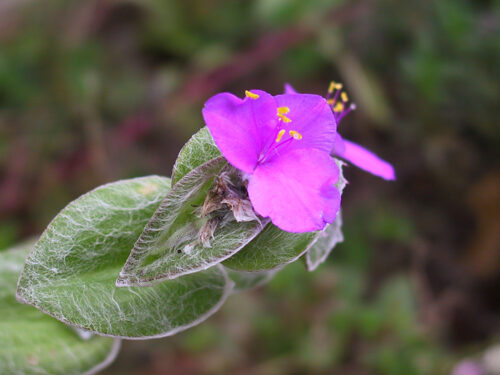
The amazing Tradescantia Sillamontana, often called Cobweb Spiderwort or White Velvet Spiderwort, is well recognized for its unusual fuzzy look. It comes from the desert areas of Mexico and is a member of the Tradescantia genus and Commelinaceae family. The exquisite pattern of fine, silvery hairs covering its leaves, which resemble fragile cobwebs, is where the name “Cobweb Spiderwort,” which means “Spiderweb Spiderwort,” comes from. Its velvety leaves add to its charm, making it a favorite among collectors and plant aficionados.
The leaf of the Tradescantia Sillamontana is its most noticeable characteristic. The lance-shaped leaves have a rich covering of tiny, silvery-white hairs that, when touched, feel velvety and silky. As an adaptation mechanism, these hairs reduce water loss and provide defense against excessive sunlight and associated dangers. The dark green foliage of other houseplants contrast well with the shimmering silver hue of the leaves.
The plant’s ability to withstand drought is one of its best traits, making it a great option for those who may not consistently water their plants. It is perfect for xeriscaping or water-saving landscaping projects because to its drought tolerance and minimal care requirements.
The Cobweb Spiderwort has a fascinating look and is little maintenance, and it also has beautiful blooms. The tiny blossoms offer a touch of elegance to the whole display, although not being as prominent as those of some other plants. These delicate, three-petaled blooms, which are tiny and come in a variety of light pink hues, gracefully pop out from the plant’s silvery leaves, adding to its allure.
A flexible plant that works in a variety of environments and gardening techniques is Tradescantia sillamontana. It is cultivable as a ground cover in outdoor gardens, producing a thick carpet of velvety leaf that gives the environment texture and aesthetic appeal. It serves as a ground cover and inhibits the development of weeds in addition to preventing soil erosion.
For a touch of originality and beauty in any space, indoor gardeners may grow Cobweb Spiderwort in a pot. Its silvery, cobweb-like leaves provide an eye-catching show when placed on a windowsill or tabletop; this attracts attention and starts conversations. It is a great option for households or flats with little sunshine because of its modest size and low light needs.
Even for novice gardeners, taking care of the Cobweb Spiderwort is not too difficult. For it to be healthy, the soil must drain well and resemble the dry environment in which it was born. A regular potting mix with additional perlite or sand might provide the optimal soil composition for indoor cultivation. The pot’s enough drainage holes avoid soggy roots, which may cause root rot.
The Cobweb Spiderwort wants to stay on the drier side when it comes to watering, so avoid overwatering. In order to avoid root problems and preserve the soil’s general health, it is essential to let the soil somewhat dry out in between waterings. Finding a balance is crucial, however, since extended dry spells without any water may be harmful to the health of the plant.
A variety of lighting situations are acceptable to the Tradescantia Sillamontana. It can live in some shade as well as strong, indirect light, where it flourishes. It’s best to put it next to a window with a south or east exposure that has a sheer curtain for filtered light. Avoid leaving it out in the sun for long periods of time as this might result in leaf burn and discolouration.
It is advised to regularly prune the plant to preserve its bushy and compact growth pattern. Cutting down lanky or overgrown stems promotes new development and aids in the plant’s ability to maintain its appealing look. When the plant is actively developing, in the spring or early summer, is the optimal time to prune.
The Tradescantia Sillamontana is reasonably easy to propagate by stem cuttings or division. You may take healthy, mature stem cuttings and root them in either water or soil. The process of division entails cutting the plant into smaller clumps, each having a section of the root system, and replanting each one separately. Both techniques work well, and after the young plants get their roots down, they will develop into rich, lovely examples that are ready to show off their alluring beauty.
Care Tips: Tradescantia Sillamontana prefers bright light but can tolerate partial shade. Allow the soil to dry out between waterings, and avoid overwatering, as this can lead to root rot. Prune the plant occasionally to remove dead growth and maintain its shape.
6. Tradescantia Ohiensis
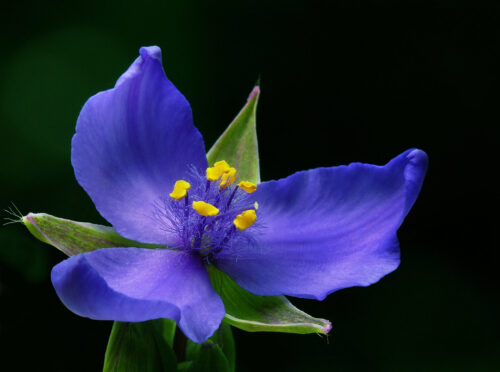
North American native plant Tradescantia Ohiensis, sometimes called Ohio Spiderwort or Bluejacket, is magnificent. This perennial has gained popularity as a much-loved addition to many gardens and landscapes because to its striking blue-violet blossoms. The alluring blossoms are a beautiful addition to flowerbeds and borders and also play a vital function in luring pollinators and butterflies, making them a healthy and advantageous option for any outdoor area.
The eastern United States and certain portions of Canada are among the natural habitats of Tradescantia Ohiensis, a member of the Commelinaceae family. Carl Linnaeus, a prominent Swedish botanist, published the first description of the plant in 1753. Its specific name, “Ohiensis,” alludes to Ohio, the location of the plant’s first discovery.
With its lengthy, grass-like leaves, which are normally between 12 and 18 inches long, the plant has a distinctive look. Even when the plant is not in flower, these bluish-green leaves, which develop in clumps, contribute to the overall appeal of the plant. The Ohio Spiderwort has gorgeous spider-like blooms, as the name implies, that appear on long, leafless stalks. Three stunning blue-violet petals make up the magnificent flowers, which often frequently include striking yellow stamens in the center. Typically, the blooms bloom in the morning and fade by lunchtime or early afternoon.
It is impossible to exaggerate Tradescantia Ohiensis’ importance for the environment. It is hardy and well-adapted to the environment since it is a native species that has evolved to flourish there. This adaptability includes its capacity to attract and sustain a variety of pollinators, including as bees, butterflies, and hummingbirds. These species rely heavily on the nectar-rich blooms as a source of food, which improves the ecosystem’s general health and biodiversity.
Additionally, long-tongued bees, who have a mutualistic connection with the Ohio Spiderwort, are known to pollinate the plant’s colorful blooms. These bees’ mouths have developed to be ideal for sucking honey from tubular blooms. In exchange, they unintentionally spread pollen throughout flowers, aiding the plant’s fertilization and seed generation processes.
Tradescantia Ohiensis has cultural value for several Native American tribes in addition to its ecological relevance. Native Americans have traditionally utilized the herb as a medicine. To make poultices for the treatment of wounds, bug bites, and skin irritations, the leaves were often pulverized. Some tribes also utilized the roots to prepare teas with what they thought to be medicinal benefits for a number of diseases.
The Ohio Spiderwort has recently come to represent native plant preservation and ecological restoration initiatives. To enhance biodiversity and safeguard regional ecosystems, gardeners, horticulturists, and conservationists understand the value of including native plants like Tradescantia Ohiensis in their landscapes.
It’s not difficult to grow Tradescantia Ohiensis in a garden or landscaping project. The plant loves well-drained locations with moderate moisture levels, although it may grow in a variety of soil types, from sandy to loamy. Although it may take some shade, growing it in full sun tends to result in more blossoms. Ohio Spiderwort is a hardy perennial that, once established, takes little upkeep, making it a great option for naturalized areas or low-maintenance gardens.
Tradescantia Ohiensis works well with other native plants and wildflowers to create a unified landscape design. A vivid and eye-catching display may be made by pairing its contrasting blue-violet blossoms with yellow or orange flowers. Incorporating native plants like Ohio Spiderwort is a conscientious approach to help the local environment and animals when designing a garden or landscaping project.
The potential for an introduced plant species to become invasive is a crucial factor to take into account. Tradescantia Ohiensis is not regarded as an aggressive intruder, nevertheless. Because it is endemic to the area, it has coevolved with natural flora and wildlife, preserving the ecosystem’s equilibrium. To avoid unexpected repercussions and ecological disturbances, it is always crucial to monitor the development of any plant, particularly in locations where it is not native.
Care Tips: Tradescantia Ohiensis thrives in full sun to partial shade and prefers well-draining soil. Keep the soil consistently moist during its growing season, and reduce watering during winter when the plant goes dormant.
7. Tradescantia Spathacea (Oyster Plant)
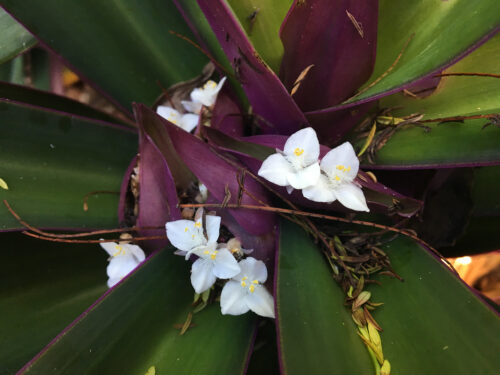
The Tradescantia Spathacea, or oyster plant, is a fascinating indoor plant that has unique spoon-shaped leaves with eye-catching patterns. It is a popular option for lovers of indoor gardening and interior designers because of its foliage, which mixes deep green and purple tones and lends a sense of tropical beauty to any indoor room.
Botanist William Swainson originally described the oyster plant in the early 19th century. It is a member of the Commelinaceae family and is indigenous to Central America and certain regions of southern Mexico. Both “Oyster Plant” and “Boat Lily,” which are two of its popular names, refer to the distinctive form of its leaves, which resemble little boats or oysters.
The leaves of the oyster plant gently arch outward from a central point, exhibiting a captivating rosette growth pattern. Each leaf is long and spoon-shaped, ranging in length from 6 to 12 inches. The leaves’ top surfaces are rich green in color, while their bottom surfaces are a stunning purple tone. This remarkable contrast captures the attention of onlookers.
In addition to its magnificent leaves, the oyster plant sometimes sprouts small, three-petaled white flowers, which elevate its entire appearance with a delicate charm. However, this houseplant’s foliage continues to be its major draw.
Given its relatively minimal care requirements and ability to thrive in indoor environments, the oyster plant is a popular choice for indoor plants. It does best in settings with filtered sunlight or away from direct exposure to strong rays since it flourishes in bright, indirect light. The purple tones in the foliage could become less prominent, but it can endure reduced light levels.
The Oyster Plant loves soil that is somewhat damp but not soggy when it comes to irrigation. Between waterings, the top inch of the soil must completely dry out in order to avoid problems like root rot. While it’s best to water often during the growth season, which is normally in the spring and summer, watering less frequently in the autumn and winter may help avoid overhydration.
The health of the oyster plant depends on maintaining a warm, humid climate. It prefers a relative humidity of 50% or more and thrives in temperatures between 65°F and 80°F (18°C and 27°C). Indoor gardeners may water the leaves periodically, utilize humidity trays, or use room humidifiers to attain the correct humidity.
The Oyster Plant requires a potting medium that drains well and is full of organic content. During the growing season, regular fertilization with a balanced, water-soluble fertilizer may encourage healthy development and improve the brilliance of its leaves.
The Oyster Plant is a popular option for interior designers and indoor gardening aficionados because to its charming look and simplicity of maintenance. Whether it’s a living room, bedroom, workplace, or little corner in the house, its colorful and distinctively patterned leaves instantly offer a touch of tropical beauty.
The plant thrives as a tabletop plant where its attractive leaf becomes the focus of attention thanks to its rosette growth pattern, which with time transforms into a bushy, clumping shape. It is also a great choice for hanging planters because of its delicately cascading leaves, which bring a touch of natural elegance to hung displays.
Due to its versatility to different pot sizes and designs, the oyster plant is simple to include into a variety of interior design themes. This attractive houseplant naturally compliments and improves the overall mood, whether in modern, bohemian, or minimalist rooms.
Some indoor gardeners choose the oyster plant for its air-purifying qualities rather than just its decorative worth. The oyster plant is an eco-friendly option for building a healthier living environment since, like many other plants, it helps to cleaner indoor air by absorbing pollutants and poisons from its surroundings.
Oyster plants are reasonably simple to grow, giving indoor gardeners the chance to add to their collection or spread the delight of this lovely species to loved ones. Dividing the plant’s clumps is the most normal technique of propagation, usually done in the growing season while the plant is actively generating new growth.
Divide a plant by gently removing it from its container and separating the various rosettes, making sure that each split has a sound root system. With the right care, these divided rosettes may be planted in new soil and will grow into distinct plants.
Additionally, pruning may support the plant’s maintenance of the ideal size and form, particularly when grown in constrained locations. In addition to improving the plant’s look, routine leaf removal from yellowing or damaged areas will help encourage new growth and improved general health.
Care Tips: Tradescantia Spathacea prefers bright, indirect light but can tolerate lower light conditions. Water it moderately, allowing the soil to dry out slightly between waterings. Mist the leaves occasionally to maintain humidity and keep the plant healthy.
8. Tradescantia Virginiana
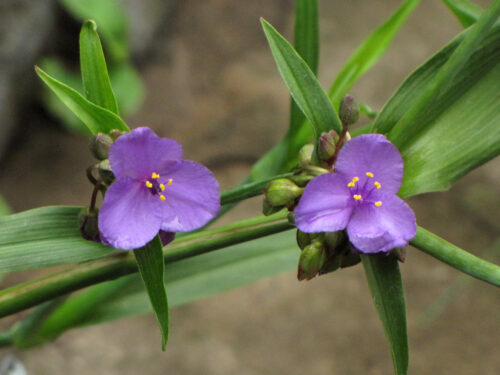
The intriguing perennial plant Tradescantia Virginiana, sometimes referred to as Virginia Spiderwort, is native to North America and has stunning blue-purple flowers. It has gained popularity among gardeners who want to improve the look of their outdoor areas with the help of its seductive blossoms and lovely leaves.
The three-petaled blooms of the Virginia Spiderwort, a member of the Commelinaceae family, make it stand out because they open in the morning and shut in the afternoon. Tradescantia Virginiana is the scientific name for this plant and honors the famous English botanist and gardener John Tradescant.
This plant may grow in a variety of habitats, flourishing in open forests, meadows, and next to wetlands in its native habitat. Its capacity to thrive in a variety of environments makes it a popular option among gardeners from varied climes and geographic areas. The Virginia Spiderwort exhibits its lovely blue-purple blooms in either full sun or partial shade, attracting butterflies and bees and enhancing the biodiversity of the garden.
Even when the blossoms are not fully visible, the plant’s foliage nevertheless captures the eye and complements them. Its elegant cluster of long, thin, blade-like leaves may grow over time to produce a rich ground cover. The brilliant blossoms and the lovely contrast between the green leaves’ hue and the green of the petals enhance its allure.
The Virginia spiderwort’s minimal care requirements are one of its best features. It thrives with little work, making it a great option for both seasoned and beginning gardeners. Since it is a perennial, it returns each year, giving the garden dependable beauty and color without the need for regular replacing.
It is essential to take the soil conditions into account to promote optimum development. The plant can handle a variety of soil types, although it favors loamy, well-draining soil with a moderate moisture content. It is possible to improve the structure and fertility of the soil before to planting, which will help the plant establish itself and flourish.
Regular watering is crucial throughout the active growth season, which normally lasts from late spring to early autumn, particularly during extended dry periods. But after taking root, the plant develops some drought tolerance, making it suited for places with variable rainfall.
Deadheading fading flowers may help extend the blooming season. The plant may focus its efforts on developing new blooms by removing spent flowers. Regular trimming also aids in limiting its growth and preserving a tidy look.
Beyond its visual appeal, the Virginia spiderwort aids the local ecosystem ecologically. With the help of bees, butterflies, and other helpful insects, it attracts pollinators with its alluring blossoms, which are a significant food source. These insects unwittingly aid the reproduction of other surrounding plants via pollination.
Additionally, the plant’s thick foliage serves as a haven for insects and tiny animals, enhancing the richness of the garden environment overall. As a result, the Virginia Spiderwort is essential to maintaining a healthy and vibrant natural habitat.
Care Tips: Tradescantia Virginiana prefers full sun to partial shade and well-draining soil. Water it regularly, particularly during dry spells, to keep the soil moist. Deadhead spent flowers to promote continuous blooming.
Conclusion
Wandering Jew plants provide a wide range of alluring types, each of which has its own special allure. These plants have become well-liked options for both indoor and outdoor gardening aficionados due to the beautiful blossoms of Tradescantia Virginiana and the brilliant colors of Tradescantia Zebrina. Wandering Jew plants are ideal for both novice and seasoned plant enthusiasts due to their minimal care requirements and capacity to flourish in many environments.
Keep in mind the particular requirements of each type, such as light specifications, watering preferences, and pruning procedures, while taking care of your Wandering Jew plants. You can guarantee that these lovely plants grow and continue to provide beauty and pleasure to your living areas by creating the ideal circumstances. So think about bringing home a couple of these alluring Wandering Jew types, and enjoy the beauty and variety they have to offer. Enjoy your garden!
